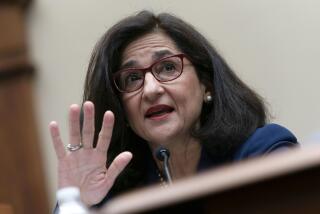President Stindt Drew Faculty’s Ire : Southwestern College Head to Step Down
- Share via
Southwestern College President Jewell E. Stindt agreed to step down from her $62,500-a-year job after the school’s board of governors voted unanimously to buy out the last 19 months of her contract.
Interviews with administrators and faculty members indicate that Stindt’s early departure was not unexpected and resulted from numerous complaints about her management style. Most people interviewed praised Stindt for bringing positive changes to the financially strapped Chula Vista campus, but they also complained that changes often were made without consulting faculty members or administrators.
“I hope that a place will be found for her talents,” said Don Lynn, a chemistry instructor who has been at Southwestern for 20 years. “But some of the faculty were probably irritated by her style of administration. She made too many unilateral changes without consulting the faculty and the deans. But I personally think that many of the things she fought for will eventually be seen as being very progressive.”
Stindt, 59, and her attorney, William Bauer, could not be reached Wednesday for comment.
Board President Robert Frazier said that Stindt’s departure “was mainly a board-instigated agreement.” According to Frazier, the agreement will allow her to collect her monthly salary of $5,127.33 until June 30, along with a monthly expense account of $422. On July 1 she will receive a lump sum of $62,500, representing the last year of her contract.
Stindt’s departure became effective Tuesday night, when the board unanimously approved the agreement, negotiated with Bauer. Frazier said she will be allowed to remain as a consultant to the Southwestern Community College District until July 1. Vice President G. Edward Thornton has been appointed acting president until the board finds a replacement for Stindt.
Frazier declined to be specific about the reasons why Stindt was asked to step down, but he echoed Lynn’s complaint that Stindt too often acted independently of her administrators and faculty members. Frazier praised Stindt for bringing “very rapid and beneficial changes to the district.”
“Unfortunately, many of these changes were difficult for the college to assimilate, like the changes in the general education curriculum,” Frazier said. “For example, she instituted a minimum competency requirement that will cause certain students to take remedial courses when they really don’t have to.”
Southwestern, a 25-year-old campus with 12,500 students, has a high minority enrollment. Campus figures show that 53% of its students are non-white, including 28% Latino and 11% Filipino.
Stindt was praised by other college administrators for making optimum use of available funds, despite a 7.7% cutback in community college funding statewide. Southwestern also has the lowest revenue base of the state’s 70 community college districts because of its low property tax rate.
Stindt established a computer training course that was generally regarded to be among the best in the state. She became Southwestern president in July, 1981, after holding administrative posts at Wayne County Community College and Schoolcraft Community College in Michigan.
Julio Garcia, dean of the math and science departments, said that Stindt was ranked “very high” in a recent evaluation by campus administrators. But he added there were “philosophical differences” between her and the group that “festered over a period of time and magnified.”
“She was a strong leader with strong philosophical ideas,” Garcia said. “But her ideas were too many at one time, and she overwhelmed the board and the deans . . . . And whenever you affect change, there’s going to be conflict. . . . It turned into a question of whether the board could accept these changes fast enough. And as it turned out, the board members could not.”
More to Read
Sign up for Essential California
The most important California stories and recommendations in your inbox every morning.
You may occasionally receive promotional content from the Los Angeles Times.













